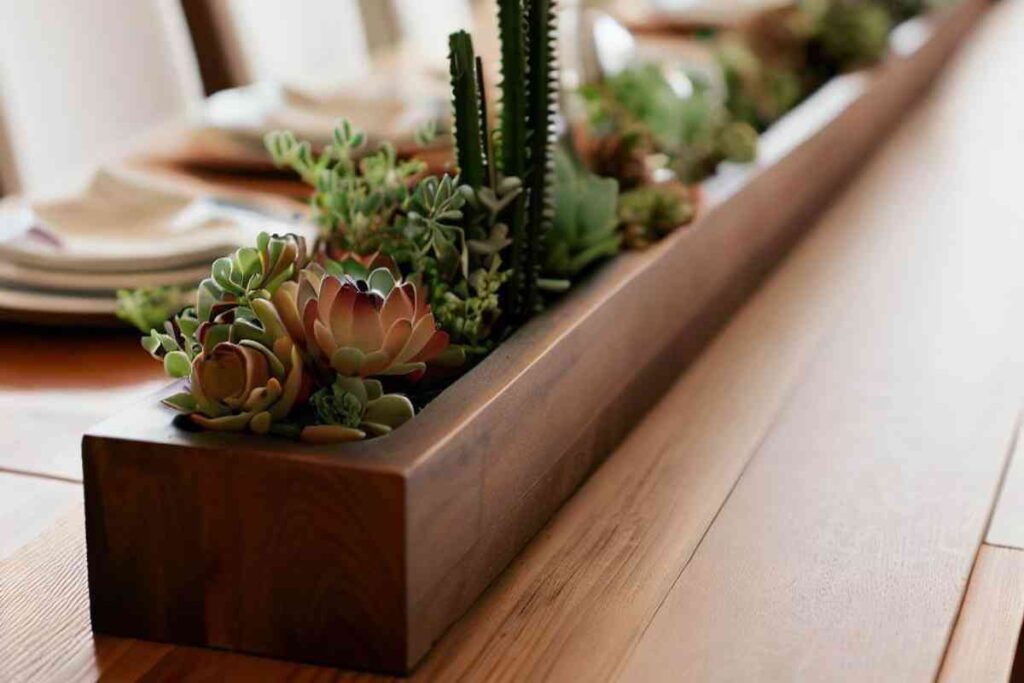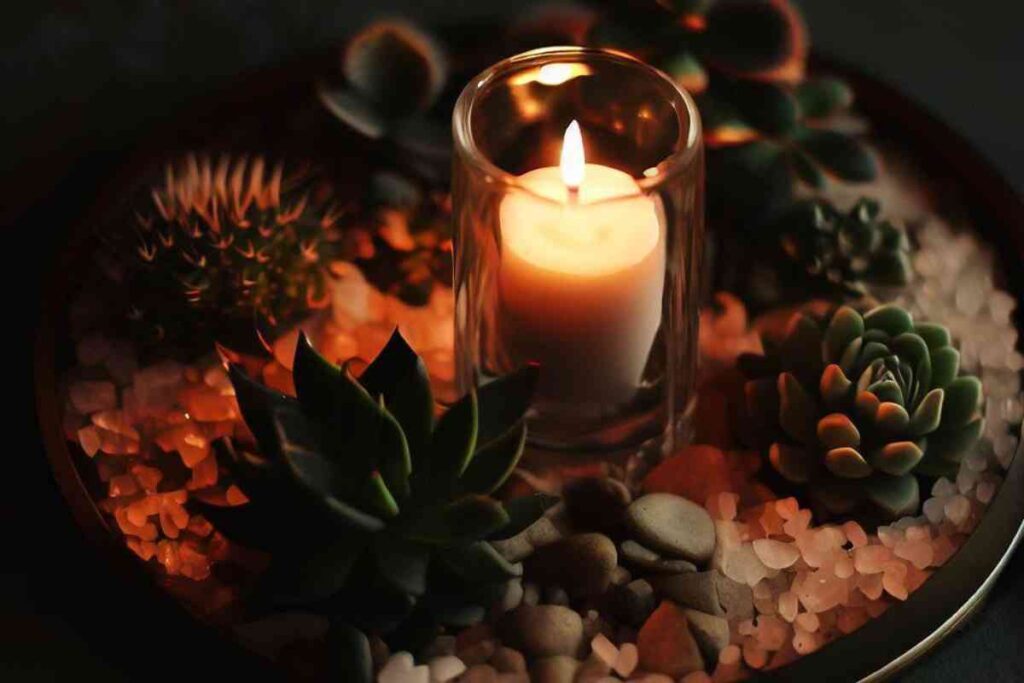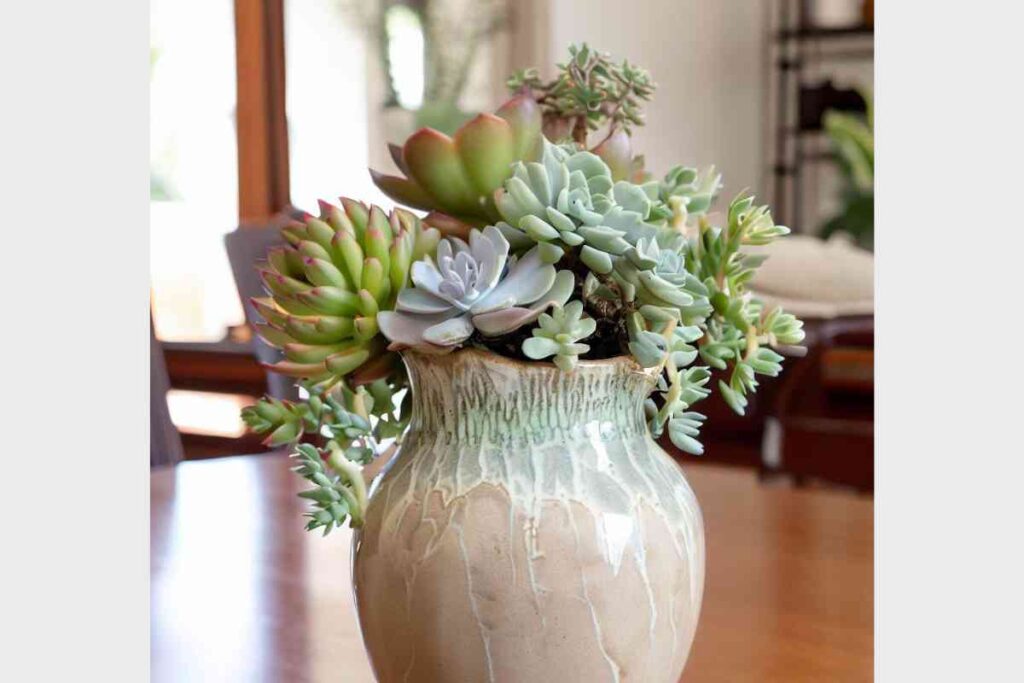7 Unique Succulent Table Arrangements

I just love seeing succulents as the centerpiece for a table. I mean, I love seeing succulents anywhere (other than dying on the shelves of big box stores… sad…), but seriously, succulents as table centerpieces just make so much sense.

I’ll go into more about that below, and I’ll also give you 7 succulent table arrangements to inspire you to transform your dining table from “bleh” to “How did you do that?!”
You’ll probably end up with some dropped leaves after you do one of the projects on this list. Use those pups to make a charming miniature succulent garden.
Want to make sure your dining room centerpiece thrives? Learn everything you need to know about growing succulents indoors.
Why do Succulents Make Good Centerpieces?
With their sandy soil and the absence of constantly shedding leaves, succulents make neat and pristine table toppers. No worrying about constantly sweeping up fallen foliage or dealing with messy plant care routines or gnats.
Whether you’re aiming for a rustic farmhouse look, a sleek modern aesthetic, or a cozy bohemian vibe, succulents fit right in. Their architectural forms and clean lines add a touch of style and flair to dining rooms, kitchens, and even outdoor patios. It’s like they were born to be centerpieces.

Another advantage of using succulents as centerpieces is their slow growth rate. Unlike other plants that require frequent replanting or trimming, succulents grow at a leisurely pace. Once you find the perfect planter and arrange your succulents, you can enjoy them for months or even years to come.
With their wide range of colors, textures, and shapes, succulents create captivating compositions that captivate the eye and spark conversations. Each succulent seems to tell a story with its unique form, inviting you to explore their intricate details and marvel at their natural beauty while you sip your coffee or enjoy your dinner.
Oh, and did I mention that succulents come in various light varieties? Just choose the ones that fit your lighting conditions. If your dining room lacks natural light, just set up a grow light chandelier! Just kidding… or am I?
Without more delay, here are the succulent centerpieces your friends will be drooling over.
1. Identical Planter Succulent Centerpiece
Picture your table adorned with three identical succulent planters. Despite their uniform containers, each planter boasts a unique collection of succulents, adding a delightful touch of diversity.

The continuity of the containers serves as the cohesive thread and draws the eye from one to another as you find yourself irresistibly comparing them and choosing a favorite.
This is one of the easiest centerpieces on this list (that’s why I started with it!). Start by choosing a range of succulents that catch your eye and complement each other. Look for a mix of vibrant hues, such as deep greens, silvery blues, rosy pinks, or even purples. Consider combining different textures as well, like spiky Echeverias, velvety Kalanchoes, or trailing Sedums. The key is to create an engaging visual contrast among the succulents.
Plant succulents that grow at different rates in separate containers. This allows you to provide individual care and prevent any overcrowding.
Arrange the succulents in each planter with an artistic eye, considering the colors and textures of each individual plant. Play with different heights and sizes to create a visually dynamic arrangement. Remember to leave enough space between the succulents to allow for growth and airflow.
2. Striking Succulent Centerpiece with an XL Focal Plant
Imagine a captivating sight at the heart of a dining room table—a large, simple planter stealing the spotlight. A colossal aloe stretches two feet into the air, commanding attention.
The clean, sharp lines of the aloe create a bold contrast against the backdrop of the dining room. Smaller succulents cluster out around it and drape over the edges of the container.

The sheer size of the centerpiece succulent instantly catches the eye. It demands admiration and serves as a focal point for the entire room.
To create this captivating display, begin by selecting a big, upright succulent that possesses a commanding presence, such as Aloe. If you have very low light, the snake plant is a good choice as well. These varieties have a natural tendency to grow vertically and can reach impressive heights, making them ideal choices.
For the surrounding succulents, choose smaller varieties that complement the grandeur of the centerpiece. Consider plants like Echeverias, Haworthias, or Graptopetalums, which offer a variety of colors, shapes, and textures. Opt for slower-growing succulents for the surrounding plants, as their smaller size will allow the centerpiece succulent to remain the focal point without being overshadowed.
When creating the display, carefully position the centerpiece succulent in the center of the large, simple planter, ensuring it has enough space to grow and flourish. Surround the towering aloe with a selection of the smaller succulents. Play with heights and placement, allowing some of the trailing succulents to spill over the edges of the planter.
3. Succulent Cornucopia Centerpiece
What brings the essence of abundance to your dining room or kitchen table like a succulent Cornucopia centerpiece, overflowing with vibrant life? Succulents spill out from the sides giving a peaceful sense of plenty.

The choice of a dish is crucial to this centerpiece. Look for a dish that lets the succulents spill gracefully over the edges, creating a sense of overflowing abundance. A terra cotta or ceramic cornucopia-shaped pot can be an excellent option. A faux clamshell or any planter with wavy sides can also work.
When selecting the succulents for the Cornucopia centerpiece, aim for a combination of trailing and clustering varieties. Trailing succulents, such as String of Pearls (Senecio rowleyanus), String of Bananas (Senecio radicans), or Burro’s Tail (Sedum morganianum), will elegantly spill over the sides of the dish, adding a cascading effect.
Cluster-forming succulents, like Echeverias, Graptoverias, or Haworthias, will create compact groupings, adding texture and variety to the arrangement.
As you assemble the centerpiece, position the trailing succulents near the edges of the dish, allowing them to gracefully spill out and drape down. Place the clustering succulents towards the center, creating dense clusters.
4. Modern Wooden Succulent Centerpiece
This is the perfect choice for an outdoor table. A square or rectangular wooden planter, brimming with a delightful array of succulents in vibrant, eye-catching colors, adds life and style to the space.
This low-profile planter, with its sharp corners and clean lines is the perfect focal point for a perfect gathering spot for conversations over drinks or a BBQ with friends.

The natural beauty of untreated wood can add rustic charm, while a treated wooden planter offers durability and weather resistance. If you’re concerned about water damage to the wood, consider using a plastic insert. This insert can be set inside the wooden planter, providing a protective barrier.
Choose one that fits snugly within the wooden planter. This insert will serve as a waterproof barrier, protecting the wood from water damage.
When it’s time to water the succulents, simply remove the insert from the wooden planter, bottom water the plants, and allow excess water to drain away. Once the planter has drained completely, the plastic insert can be placed back into the wooden box.

When selecting succulents for the planter, opt for a variety of bright colors. You can choose from brightly colored sun-loving succulents since the planter will be outside. Moon Cactus, Sempervivum Red Rubin, and Golden-Toothed Aloe are great options.
5. Long Succulent Centerpiece
A long, narrow succulent planter stretching nearly the entire length of the table allows everyone at the table to enjoy the beauty. When perfectly paired with just the right table runner, this might be my favorite centerpiece.

Materials such as wood, ceramic, or even a modern metal trough work well. When planting the succulents, aim for a combination of smaller, bunching varieties like Echeverias, Haworthias, or Graptoverias that form dense clusters, creating a lush and abundant look. Alternate with single-specimen focal points like burro’s tail or Spring Beauty to draw the eye through the design.
Avoid selecting succulents that grow excessively tall, as they may obstruct sightlines across the table and hinder conversations. Instead, opt for compact and medium-sized succulents that will maintain an appropriate height and allow for easy interaction among guests.

6. Candle and Succulent Centerpiece
This mesmerizing centerpiece combines the gentle glow of candles with the natural beauty of succulents—an enchanting display that comes alive in the evening as the flickering flames cast a warm, inviting light on the succulents.

Succulents, with their inherent ability to handle heat, are the perfect choice for this pairing, making it easier to create a centerpiece that enchants the senses.
When creating a succulent centerpiece with candles the main gaol is that the succulents aren’t overheated by the candles. Select tall glass candleholders that will create a barrier between the candles and the succulents.
Begin by adding a layer of gravel to the bottom of the container. This layer should be thick enough to allow for thorough watering of the succulents while still providing ample space for drainage. The gravel acts as a reservoir, allowing excess water to drain away, preventing waterlogging and root rot.
Next, place individual succulent pots onto the layer of gravel, ensuring they are securely positioned. Add additional gravel around the pots to hold them in place.

Carefully nestle the tall glass candleholders into the gravel, ensuring they are placed at a safe distance from the succulents.
If used regularly, the candles will likely increase the rate of water evaporation from the succulent pots. This is one of the reasons a reservoir works for this design.
Keep an eye on the water level and ensure it doesn’t reach the pots. Allow enough time for the water to evaporate before the next watering.
7. Succulent Bouquet Centerpiece
Rarely am I caught off guard by a succulent display, but this one really got me the first time I saw it. I saw a bouquet on a friend’s dining room table. My first thought was, “Wow, that is a stunning bouquet.” My next thought was, “Wait, those aren’t flowers!”

It was made entirely of succulents! Delicate floret-style succulents, arranged in a way that mimicked the appearance of a traditional floral arrangement. Each succulent was positioned to mimic a flower; their rosette shapes intertwining and cascading over one another.
Needless to say, I was impressed, and my friend was smug. Of course I was going to make one myself.
Creating a succulent bouquet can be a bit tricky, but the results are definitely worth the effort. To begin, choose an open-mouthed vase that provides enough space to accommodate a shallow pot.
It should be heavy, since the succulents will be at the top of the vase and can make it top-heavy. If choosing a lighter vase, it’s a good idea to weight it down with some rocks inside.
The shallow pot will serve as the base for the succulents. Don’t worry if the pot is a little bit visible. The succulents will hide it.

It’s important that the pot has proper drainage to prevent waterlogging and promote healthy succulent growth. However, the vase itself doesn’t necessarily require drainage holes, as long as the water level remains well below the bottom of the pot. If necessary, you can easily remove the pot from the vase to water the succulents and then place it back, or pour out excess water after watering.
To create the arrangement, select floret-style succulents that resemble flowers.
Rosette Style Succulents that Resemble Flowers
- Echeveria ‘Perle von Nürnberg’: This stunning succulent features rosettes with pastel purple-gray leaves. The edges of the leaves have a delicate pink hue, giving them a soft and dreamy appearance. ‘Perle von Nürnberg’ produces slender stems topped with clusters of pale pink, bell-shaped flowers.
- Graptopetalum paraguayense (Ghost Plant): Known for its ghostly, pale grayish-blue leaves, this succulent forms tight rosettes that elegantly overlap. The leaves have a powdery, slightly waxy texture, and their color can intensify under brighter light conditions. In the spring, Ghost Plant produces dainty, star-shaped flowers in shades of pink or white.
- Graptosedum ‘California Sunset’: This hybrid succulent combines the best features of its parent plants—Graptopetalum and Sedum. It showcases rosettes with elongated, fleshy leaves that transition from pale green to shades of pink and apricot. ‘California Sunset’ adds a warm and vibrant touch to any arrangement.
- Pachyveria glauca ‘Little Jewel’: This compact succulent forms tight rosettes of blue-gray leaves adorned with a powdery coating. The foliage takes on a subtle pinkish hue when exposed to bright light. ‘Little Jewel’ produces delicate clusters of yellow flowers atop thin stalks, adding a touch of brightness to the arrangement.
These succulents typically have compact rosette shapes that lend themselves well to mimicking the appearance of blooms. Arrange the succulents in the pot so that their roots are tucked securely inside, providing the necessary support, while the florets drape out and over each other like a blossoming bouquet.
You may need to remove leaves to settle them in appropriately. Don’t worry! It won’t hurt your succulents, and you can grow more with the leaves!
As you arrange the succulents, ensure that the edges of the pot are covered. Position each succulent in a way that their tips appear to gracefully emerge among the other florets.

General Tips for Succulent Centerpieces
- Ensure proper drainage: Select a container with drainage holes or use a separate pot with drainage and place it inside the decorative container to prevent waterlogging and promote healthy succulent growth.
- Protect your table: Place a tray or saucer under the centerpiece to catch any excess water and prevent damage to your dining room table. Be sure to watch for condensation as well as leaks.
- Consider movability: Opt for a centerpiece that can be easily moved when you want to use the table for meals or other activities if you use only one table for dining and everyday life.
- Visibility and functionality: Choose a centerpiece that allows for clear visibility across the table, ensuring that it doesn’t obstruct conversations. The arrangement should be at a height that doesn’t impede sightlines and leaves space for dining comfortably.
- Suitable lighting conditions: Select succulents that will thrive in the available light in your chosen location. If the light is uneven, consider either choosing a mix of succulents with varying light requirements or regularly rotating the arrangement to ensure even light exposure.
- Mindful watering: Water the succulents sparingly, allowing the soil to dry out between waterings to prevent overwatering and root rot. Adjust your watering schedule according to the specific needs of the succulents in your arrangement.
- Occasional maintenance: Regularly inspect and remove any wilted or unhealthy succulents to maintain the overall appearance and health of the centerpiece. Consider propagating and replacing any declining plants to keep the arrangement vibrant and fresh.
Now that you have some great ideas for the dining room, make sure to find the best succulents for your bedroom.
Worried your succulent centerpiece isn’t going to make it? Don’t be. Read this beginner’s guide to learn everything you need to know to grow a healthy dining room centerpiece.

